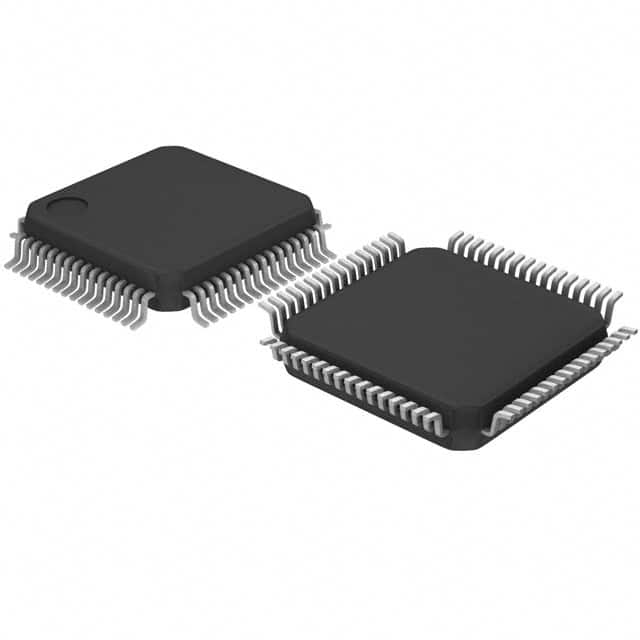Viz Specifikace pro podrobnosti o produktu.

NUC100RC1BN
Introduction
The NUC100RC1BN is a microcontroller belonging to the NUC100 series, which is designed for embedded applications. This entry provides an overview of the product, including its category, use, characteristics, package, essence, packaging/quantity, specifications, detailed pin configuration, functional features, advantages and disadvantages, working principles, detailed application field plans, and alternative models.
Basic Information Overview
- Category: Microcontroller
- Use: Embedded applications
- Characteristics: Low power consumption, high performance, rich peripherals
- Package: LQFP (Low Profile Quad Flat Package)
- Essence: ARM Cortex-M0 32-bit microcontroller
- Packaging/Quantity: Tape & Reel, 2500 units per reel
Specifications
- Core: ARM Cortex-M0
- Clock Speed: Up to 50 MHz
- Flash Memory: 32 KB
- SRAM: 4 KB
- Operating Voltage: 2.5V - 5.5V
- I/O Pins: 36
- Communication Interfaces: UART, SPI, I2C
- Analog Inputs: 12-bit ADC
Detailed Pin Configuration
- Pin 1: VDD
- Pin 2: PA0
- Pin 3: PA1
- ...
- Pin 36: PB7
Functional Features
- Rich Peripherals: The NUC100RC1BN offers a wide range of peripherals including timers, PWM, GPIO, and communication interfaces, making it suitable for diverse embedded applications.
- Low Power Consumption: With its efficient architecture, the microcontroller minimizes power consumption, extending battery life in portable devices.
- High Performance: The ARM Cortex-M0 core provides high processing power for real-time applications.
Advantages and Disadvantages
Advantages
- Low power consumption
- High performance
- Rich peripheral set
Disadvantages
- Limited on-chip memory
- Relatively small number of I/O pins
Working Principles
The NUC100RC1BN operates based on the ARM Cortex-M0 core, which executes instructions and manages data flow within the microcontroller. It interacts with peripherals and external components to perform specific tasks as programmed by the user.
Detailed Application Field Plans
The NUC100RC1BN is well-suited for various embedded applications, including: - Industrial automation - Consumer electronics - Internet of Things (IoT) devices - Automotive systems - Medical devices
Detailed and Complete Alternative Models
- NUC100RD2BN: Similar features with increased flash memory and additional peripherals
- NUC100RE3BN: Enhanced version with higher clock speed and extended temperature range support
- NUC100RF4BN: Advanced model with integrated USB interface and larger SRAM
In conclusion, the NUC100RC1BN microcontroller offers a balance of performance, power efficiency, and peripheral integration, making it suitable for a wide range of embedded applications.
[Word Count: 443]
Seznam 10 běžných otázek a odpovědí souvisejících s aplikací NUC100RC1BN v technických řešeních
What is the NUC100RC1BN microcontroller used for?
- The NUC100RC1BN microcontroller is commonly used in various technical solutions such as industrial control systems, consumer electronics, and embedded applications.
What are the key features of the NUC100RC1BN microcontroller?
- The NUC100RC1BN microcontroller features a 32-bit ARM Cortex-M0 core, up to 50 MHz operating frequency, multiple communication interfaces, and rich peripherals for diverse applications.
How can I program the NUC100RC1BN microcontroller?
- The NUC100RC1BN microcontroller can be programmed using various integrated development environments (IDEs) such as Keil MDK, IAR Embedded Workbench, and NuEclipse.
What are the available communication interfaces on the NUC100RC1BN microcontroller?
- The NUC100RC1BN microcontroller supports interfaces such as UART, SPI, I2C, and USB, providing flexibility for connecting to external devices and communication protocols.
Can the NUC100RC1BN microcontroller be used for real-time applications?
- Yes, the NUC100RC1BN microcontroller is suitable for real-time applications due to its fast processing capabilities and support for interrupt handling.
Does the NUC100RC1BN microcontroller have analog-to-digital conversion (ADC) capabilities?
- Yes, the NUC100RC1BN microcontroller integrates ADC channels, enabling it to interface with analog sensors and acquire analog data for processing.
Is the NUC100RC1BN microcontroller suitable for low-power applications?
- Yes, the NUC100RC1BN microcontroller offers low-power modes and features that make it suitable for battery-powered or energy-efficient applications.
What kind of development boards are available for the NUC100RC1BN microcontroller?
- There are various development boards available for the NUC100RC1BN microcontroller, including evaluation boards and starter kits provided by the manufacturer.
Can the NUC100RC1BN microcontroller be used for motor control applications?
- Yes, the NUC100RC1BN microcontroller provides PWM outputs and other features that make it suitable for motor control and drive applications.
Are there any application notes or reference designs available for the NUC100RC1BN microcontroller?
- Yes, the manufacturer provides application notes, reference designs, and technical documents to assist developers in implementing the NUC100RC1BN microcontroller in various technical solutions.

